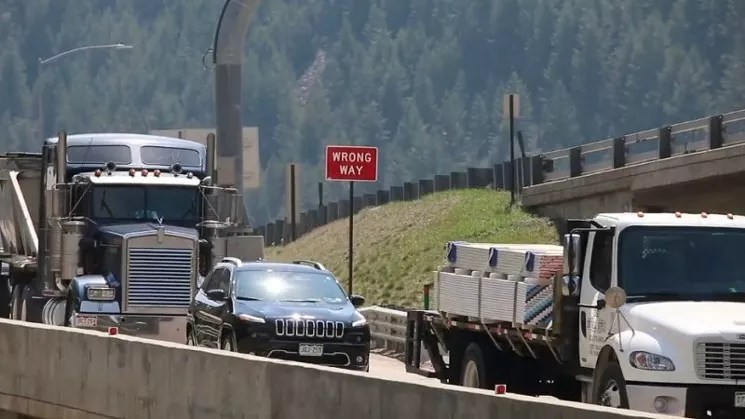
Colorado Department of Transportation

Audio By Carbonatix
Colorado might be known for its mountains, but nothing can bog down a fun ski trip like traffic – of which there is plenty along the Interstate 70 mountain corridor. According to an August study by the nonprofit I-70 Coalition, 95 percent of study participants said they use multiple strategies to deal with mountain traffic, including leaving the hills early, or leaving late, or avoiding weekend mountain traffic altogether by staying through Sunday night.
In 2015, the Colorado Department of Transportation opened an eastbound, thirteen-mile-long express lane from Empire through the Veterans Memorial Tunnels with the goal of reducing congestion and accidents. (A westbound express lane is set to open in late 2020, widening the twelve-mile stretch between the Veterans Memorial Tunnels and Empire Junction.)
How effective has the express lane been? We spoke with Kelly Brown, tolling operations manager for the High Performance Transportation Enterprise, an entity within CDOT that oversees express lanes, among other projects, and HPTE director Nick Farber to find out if the express lane is worth the price of admission, if it has reduced accidents, and more.
Westword: How much faster is traffic moving on I-70?
Kelly Brown: On average, considering both the peak and non-peak times, traffic is moving eight miles an hour faster in the express lane versus the general purpose lane.
Has traffic improved during non-holiday travel periods? If so, by how much?
Brown: The EB I-70 Mountain Express Lane has improved traffic flows through the corridor both for holiday and non-holiday weekends. Average time saved by using the lane is five minutes.
How many people use the toll lane on any given day?
Brown: The Mountain Express Lane is only allowed to be open 100 days per year and is intended to be used during peak travel times. For the 2016-2017 season (November 1, 2016, through October 31, 2017), the average daily volume for the days the Mountain Express Lane was open was 2,600 (vehicles per day) or 7.9 percent of all traffic in the corridor. As of June 30, 2019, 65 percent of customers in the corridor were express toll-pass account holders, and the other 35 percent were License Plate Toll transactions.
Is there a goal for how much time the Express Toll saves?
Nick Farber: The goals were just to have a better operating corridor. Before the eastbound express lane existed, you could sit for an hour or more between Empire and the Twin [Veterans] Tunnels. Now we see much better throughput through those thirteen miles. That was the goal – to move traffic better throughout that corridor. From what we’ve seen, if you look at the heat maps before and after, there’s a significant difference overall.
If you’re sitting in the car for a long time, from the tunnels all the way to Empire, [a decrease of] five minutes is helpful. We’re not just focused on express lanes; we’re focused on the whole corridor. It’s helped for those who’ve chosen to use the express lane, and it’s helped those who have chosen to stay in the general lane to have a faster, more reliable trip.
When accidents happen in the corridor, they close the lane down. Before, there was an average of 91 accidents in the winter time. After the express lane opened, there are an average of 71 per year. Clearance time is down as well.
How much money has the program collected, and where does it go?
Farber: I’m not sure how much revenue we’ve collected. It was $1.7 million last year gross. We pay E-470 to process all those tolls. We also have to pay CDOT to operate and maintain that lane for us, so whenever they plow it, if they’re doing that in the express lane as well, we pay them for that. We also have debt on that corridor. We took out $25 million for construction on that project to help fill the funding gap. So whatever is left after we spend on operations and maintenance and toll processing costs goes to pay off debt for that project.
Are there any plans to increase fares?
Brown: We look at that every year. The board has approved a toll-rate range. Within that range we determine is the volume of traffic warranting us to raise toll rates to keep the level of services that [the federal government] requires and a speed of greater than 45 miles per hour in the express lane 95 percent of the time. The toll rate is based on keeping that level of service up. On Sundays and holidays it is $7, and on Saturdays it’s $6. It costs more to process tolls for people who don’t have the electronic finder in their car; we have to determine who the owner of the car is through the Department of Motor Vehicles. We have to review images. It’s a much more manual process, which is why we have to have a higher toll rate for the license plate toll.
Farber: That’s why we’re always encouraging people to get a transponder. The sticker is free.
We’re always closely monitoring the volume, both of the express lane and the general purpose lane. We can control the volume we have to maintain the 45 miles an hour speed limit 95 percent of the time. If we’re not [maintaining that], we either have to increase occupancy or increase toll rates. If we want to move less people through the express lane, we increase toll rates. If speed rates are going down, we want less people in the toll lanes. We’re constantly monitoring the performance of that lane. We go to the board at least once a year, sometimes twice depending on performance, and recommend adjusting toll price up or down or keeping it the same.
Do you have questions about the I-70 mountain corridor express lane? Let us know in a comment or at editorial@westword.com.